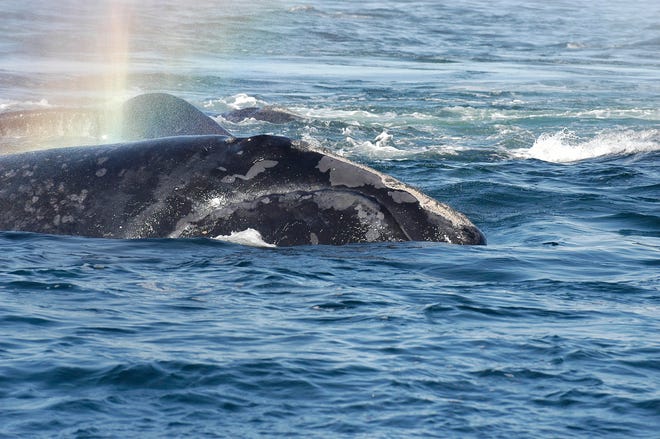Solving a mystery: How researchers found missing North Atlantic right whales
Until recently, researchers tracking the well-being of the world's most endangered great whale could count on North Atlantic right whales showing up in several key areas at certain times of the year seeking food, love, or a safe place to give birth.
In winter and early spring, a large portion of right whales could be found in Cape Cod Bay feeding on copepods, their favorite food. They then moved to the Bay of Fundy for summer feeding, where New England Aquarium researchers had been studying them since the 1980s.
But in 2010, and in the years to follow, they went missing. Although they still showed up in Cape Cod Bay, for the past decade the Bay of Fundy has been largely a right whale ghost town. The same was true for the Great South Channel east of Cape Cod and the northern edge of Georges Bank.
It took a combination of detective work and luck to eventually find them — and where they ended up dramatically altered the landscape for whale survival and fisheries management.
'It's urgent':Research shows right whales may not survive ocean warming and human impact

"Where did they go when they left New England waters in winter?" said Tim Cole, a fisheries biologist at National Oceanic and Atmospheric Administration's Northeast Fisheries Science Center, echoing a question asked by researchers all over New England in the years following 2010.
It should be relatively easy to find a 55-foot-long, 70 ton black-and-white whale, particularly when there are only more than 300 of them. But when they can swim virtually anywhere in the approximately 20 million square miles of the North Atlantic, the task of locating the North Atlantic right whale is incredibly difficult.
"It's a big ocean and they are very mobile. It's a real trick to track the population," said Cole said.
Warming water displaces a key food source
As to why they left their former summer stomping grounds, it may have a lot to do with climate change.
Andrew Pershing, the former chief scientist at the Gulf of Maine Research Institute, along with other scientists, believe that in 2010 the Gulf of Maine, which stretches from Georges Bank to the Canadian border, underwent what is known as a regime shift — a sudden change in environmental conditions that isn't easily reversed.
Encouraging sign:First right whale calf of the season spotted off South Carolina
The reason why the Gulf of Maine has been warming faster than nearly every other ocean water body on earth may be due to a weakened global current known as the Atlantic Meridional Overturning Circulation. Also known as the Great Ocean Conveyor, the AMOC is a collection of currents, including the Gulf Stream, that moves north along the surface, propelled by water heated by the equatorial sun. As it cools in northern latitudes, this water gets denser and sinks, returning south to the equator as a cold water collection of currents crawling slowly along the bottom.
Normally a cold current from Labrador and Newfoundland chills the Gulf of Maine. It creates a subarctic ecosystem that supports cold-water species like cod, haddock, northern shrimp and lobster. And, most importantly for the right whale, that subarctic environment is home to its favorite food, the lipid-rich copepod Calanus finmarchicus
But melting Greenland glaciers created a layer of fresh water on the ocean surface that is inhibiting the descent of saltwater, and scientists believe that has slowed the conveyor.
Pershing and other researchers believe the weakened cold-water currents moving north to south allowed warm water from the south to enter the Gulf of Maine through the Northeast Channel. They believe temperatures got too warm for Calanus finmarchicus and right whales left to find copepod blooms in some unfamiliar places.
"In 2012, 2013, everyone was asking, 'Where are the right whales going?'" said Peter Corkeron, a senior scientist and chairman of the Kraus Marine Mammal Conservation Program at the New England Aquarium's Anderson Cabot Center for Ocean Life.
They had two rather obvious but important clues to consider in their search for the highly social, highly mobile animals.
"They want to be around females," said Cole. "It's all about food and sex."
American researchers, consulting with Canadian scientists, believed some may have relocated to cooler Canadian waters when finmarchicus blooms did occur. In 2015, Yvan Simard, a krill specialist for the Canadian Department of Fisheries and Oceans, working on the ecology of this whale's forage species, started picking up a lot of right whale sounds at underwater listening posts he had set up to monitor shipping lanes in the Gulf of St. Lawrence.
Cole, who works with other scientists conducting aerial surveys to find and document right whales, was able to negotiate with the Canadian government to bring the NOAA plane up to the Gulf of St. Lawrence to search for them in 2015. But 2017 was the first year they had the funding and time to do a comprehensive search — and they located a lot of right whales, Cole said.
Danger in Gulf of St. Lawrence shipping lanes
A paper published this fall in the online journal Endangered Species Research on the aerial surveys of Canada, by lead author Leah Crowe of Integrated Statistics in Woods Hole —along with Cole, Corkeron and other NOAA, Anderson Cabot, and Canadian researchers — found that 40% of the right whale population was in the Gulf of St. Lawrence from May to December and that most of them — 140 — returned year after year.
Unfortunately, the Canadians did not have whale protections similar to those in the U.S., like weak links on lobster and crab pot buoy lines that would release under pressure, or shipping lanes that were relocated to route heavy ship traffic past feeding grounds or migration routes.
The result was a record year of human-caused mortalities, with 17 confirmed dead right whales (12 in Canada and five in the United States). Since 2017, there have been 34 confirmed dead whales (21 in Canada and 13 in the United States), and 16 more with injuries from ship strikes or entanglement that are deemed likely to be fatal. Scientists have estimated that for right whales to rebuild and avoid extinction, less than one animal per year can perish from human causes.
In 2017, the aerial survey was repeatedly interrupted as they spotted dead, injured or entangled right whales and had to pause in their efforts to help rescue or necropsy teams find the animals.
"We arrived and the first thing we were asked by the DFO was could we go out and locate a carcass, and it went on and on. It was horrible," Cole said.
The Canadians were able to act quickly and decisively on the information provided to them by Cole's team and by their own survey work. In fact, Corkeron, who once worked for NOAA on whale research, said they did a better job.
When safety measures take too long to implement
"NOAA is nowhere near keeping up with what the Canadians are doing," he said. The Canadian DFO has more power to act quickly, closing areas quickly to fishing and transport once a single right whale is seen.
"It's labor intensive and it takes a lot of field work but that seems to be working to keep fisheries running and not kill a lot of whales," Corkeron said. By comparison, he cited NOAA's cumbersome process in which emergency fishery closures can take weeks or nearly a month to enact — and may be too late. Speed limits on shipping in areas where right whales have been seen are voluntary and routinely violated.
"They (Canadians) have far more stringent measures and they can be implemented quickly," said Corkeron. Massachusetts lobstermen might argue otherwise, as almost all state waters remain closed to gear using buoy lines during the winter and early spring when right whales are here.
Still, it's taken years amid the constant threat of litigation for NOAA to develop a plan to reduce the number of buoy lines in New England, make the gear more whale-safe, and mark it so that researchers can tell where whales are getting entangled.
Freeing right whales:Ropeless gear petition aims to protect marine life
Corkeron called Cole an unsung hero for his dogged work to find the whales in the Gulf of St. Lawrence. He said the study that resulted in their paper showed that one plane could find whales.
But many questions remain unanswered. Are right whales getting what they need to survive in the Gulf of St. Lawrence? While Calanus finmarchicus copepods do bloom there, so do two other copepod species that may be less nutritious.
"We're not sure if the resource in the Gulf of St. Lawrence is really good and drew the whales there, or if it is just better than other places," Cole said.
But while they know where 40% of right whales are come summer, where are the other 60% and are they going to areas where they may encounter buoy lines and ships?
"More than half are not there for 12 months, and there's this 40% somewhere else for seven months of the year," Corkeron said.
"The rest are dispersed over a pretty broad area," said Cole — hard to find, hard to protect.
Still, Cole takes comfort in the fact that, with less than 100 breeding age females remaining, roughly half the successful, breeding moms use the Gulf and seem to be getting the nourishment they need to produce calves.
"It makes this a pretty important place," Cole said.



